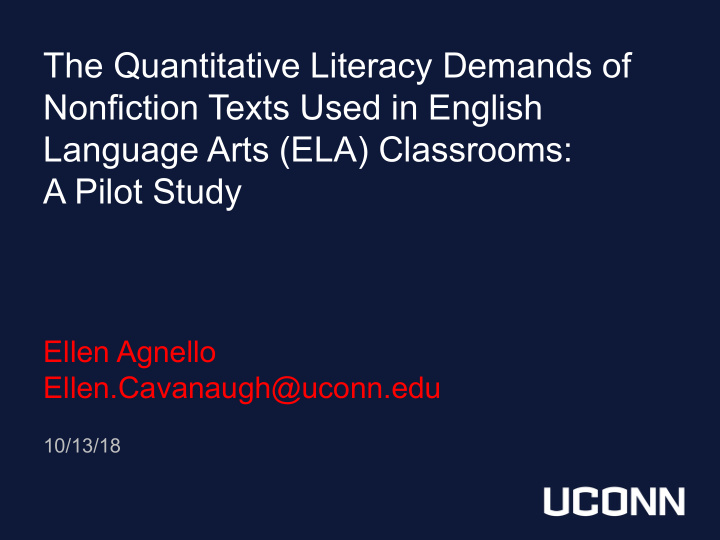



The Quantitative Literacy Demands of Nonfiction Texts Used in English Language Arts (ELA) Classrooms: A Pilot Study Ellen Agnello Ellen.Cavanaugh@uconn.edu 10/13/18
Introduction Common Core State Standards (2009) proposed major shifts in ELA teaching: Add more “nonfiction text” so that students are reading it 70% of the time by senior year. (National Governors Association Center for Best Practices, & Council of Chief State School Officers, 2010).
But what is “Nonfiction Text?” CCSS offers no definition: Instead, interchangeably uses: • “Literary nonfiction” Differ in structure , features , and • “Informational text” cognitive demands but lead teachers to think they are the same. • “Expository text”
Literary Nonfiction vs. Informational Text Multiple Modes of Representation Words Symbols Visuals
Why is this a problem? 1. The Teachers • Have autonomy, might lack the knowledge and guidance to make informed decisions (Stotsky, 2012). Types: Complexity, • Little is known about nonfiction texts taught Demands 2. The Texts • Are inherently mathematical, containing mathematical ideas and representations. Literacy depends on numeracy. • Need to be read differently than verbal items even when embedded in a verbal context (Chapman & Lee, 1990). Requires 3. The Readers ‘mathematical • Need to move flexibly between registers, thinking’ construct meaning, and transform it. (Burton, 1982). • Read embedded mathematical representations non-mathematically or not at all (Chapman & Lee, 1990).
Purpose/Research Questions The purpose of this study was to explore the nonfiction texts ELA teachers assign and the Quantitative Literacy demands that these texts pose on student readers. Research Questions: 1. 2. Which nonfiction texts are What are the Quantitative secondary ELA teachers Literacy demands of these assigning to their texts? students?
Sample and Data Collection • Sent emails to Connecticut high school ELA department heads asking them to invite Collected 41 texts: their teachers to participate in the study. 16 = narrative nonfiction • Collected nonfiction texts that participating 25 = informational teachers assign. • Only the informational texts were analyzed. • All participating teachers use online nonfiction text collections. Collected 35 Newsela texts • Cited 10 online resources. Total: 60 texts • All participants use Newsela.com
Data Analysis A manifest content analysis (Potter & Levine-Donnerstein, 1999) was conducted to determine the quantity of numeracy events, or “occasions in which a numeracy activity is integral to the nature of the participants’ interactions and their interpretive processes” (Street & Baker, 2006, p. 201). Criteria : 1. Words, mathematical symbols, visuals (graphs, tables) or a combination thereof (O’Halloran, 2005) 2. Readers must apply numeracy skills/knowledge to make inferences 3. Inferences are essential to fully comprehend the text.
Data Analysis Examples About 20% of more than 4,400 11–18-year-olds surveyed by the Cyberbullying Research Center in 2010 reported having been cyberbullied at some point in their lives. Subtraction or • % • range? 20/100 • 4,401 or any • How old are the • 1/5 • number greater respondents? 11, Less than half • 4,400/5 = 880 • 12, 13,14,15,16, Less than a quarter • At least 880 • 17, and 18. Is this a lot or a little • Is this a large • in the context? sample size?
Other examples Publishers were quickly figuring out that young people and women made up the majority of the film audiences. Nearly 70 percent of marriages, involving those under 18 end in divorce. For those who marry at 16 or younger, which is permitted in nearly 40 states, almost 80 percent of their marriages will end in divorce, Hamilton says.
Findings Articles Collected from Teachers # Articles # Numeracy Events Average/Article 25 310 12.40 Articles Collected from Newsela.com # Articles # Numeracy Events Average/Article 35 445 12.71
Implications/Conclusion • Nonfiction texts taught in secondary ELA classrooms contain numeracy events. • Successful comprehension depends on application of mathematical thinking • Explicit teaching of numeracy in the context of nonfiction text reading. • CCSS provides little pedagogical guidance: – Nonfiction text selection 26 informational text exemplars for – Text complexity ELA are all narrative nonfiction. – Teaching nonfiction texts • ELA teachers need to be aware of different nonfiction text types: – Differing text features – Differing cognitive demands • This could inform professional development
Next Steps For the current study: • Inter-rater reliability: Have at least two additional raters analyze the texts for numeracy events. • Latent content analysis : Deductively code numeracy events to determine patterns in mode of representation and levels of complexity. Related studies for the future: • Explore teacher motivations for nonfiction text selection : Awareness of numeracy events and intentions of explicitly teaching them. • Explore text simplification software : What happens to numeracy events when Newsela.com simplifies nonfiction texts containing them?
Recommend
More recommend